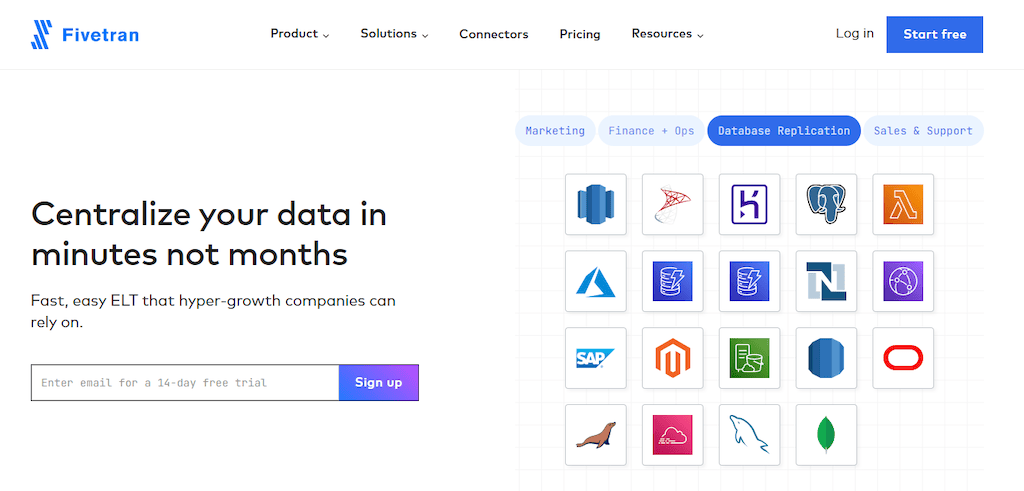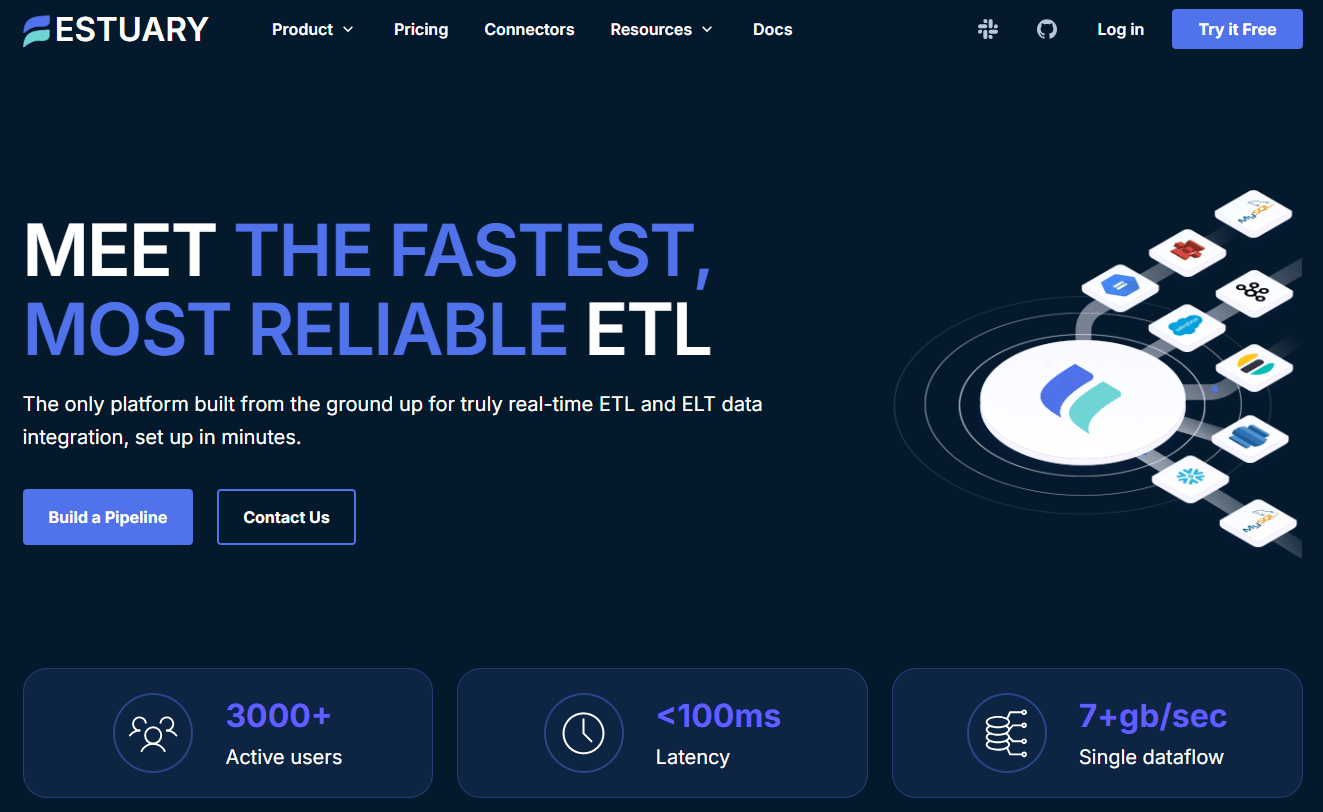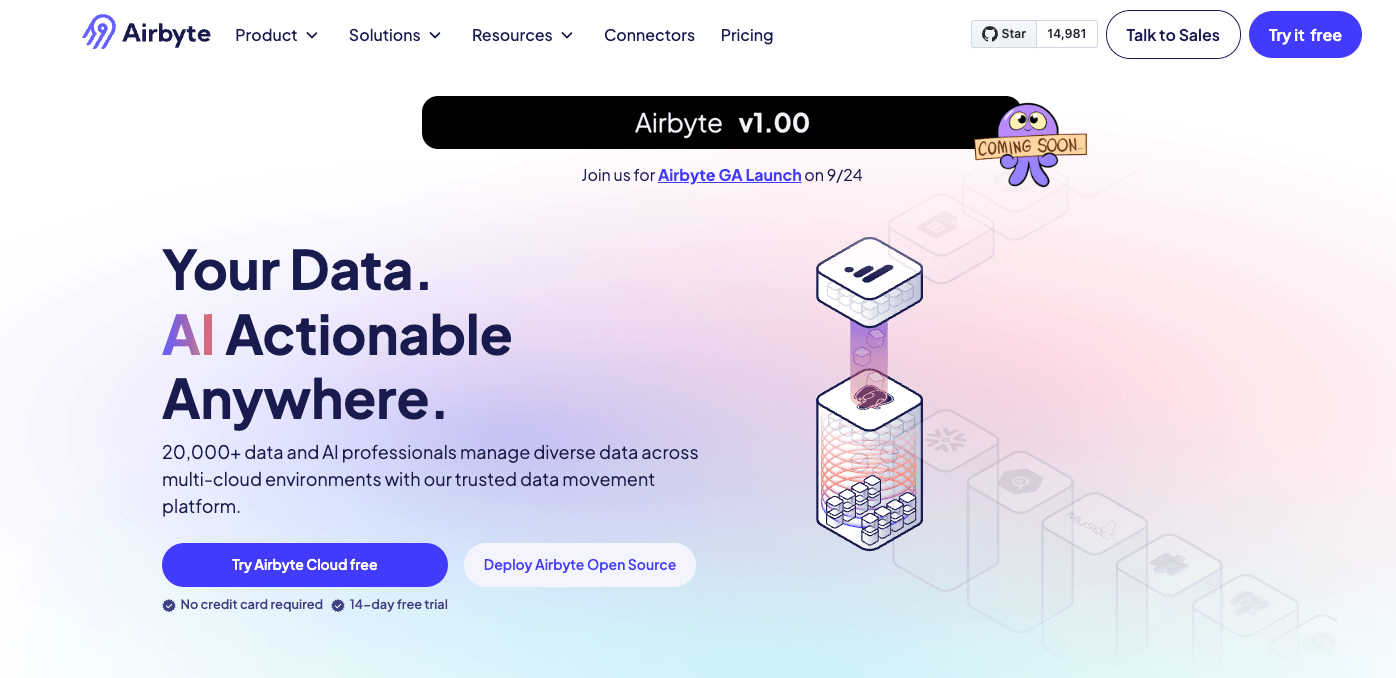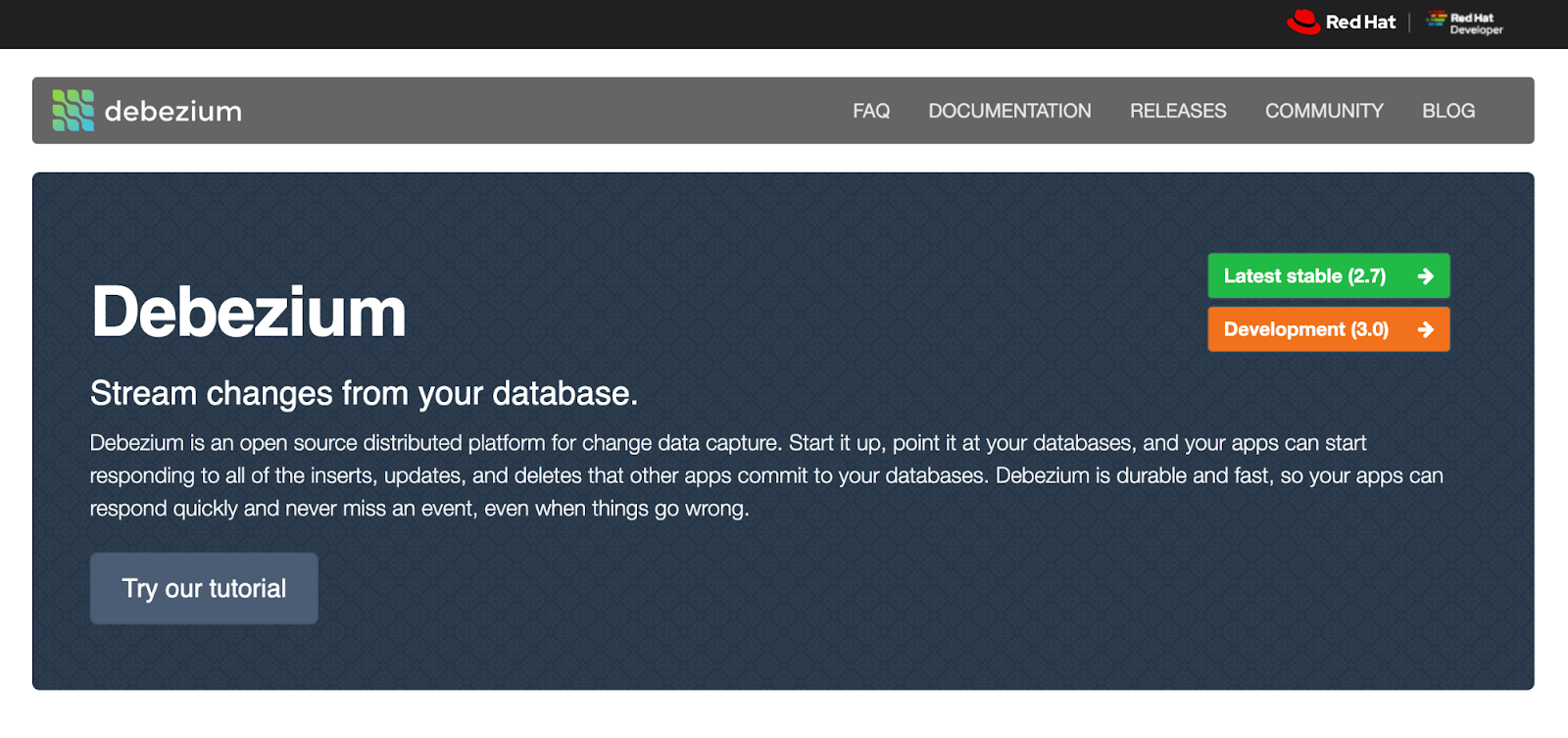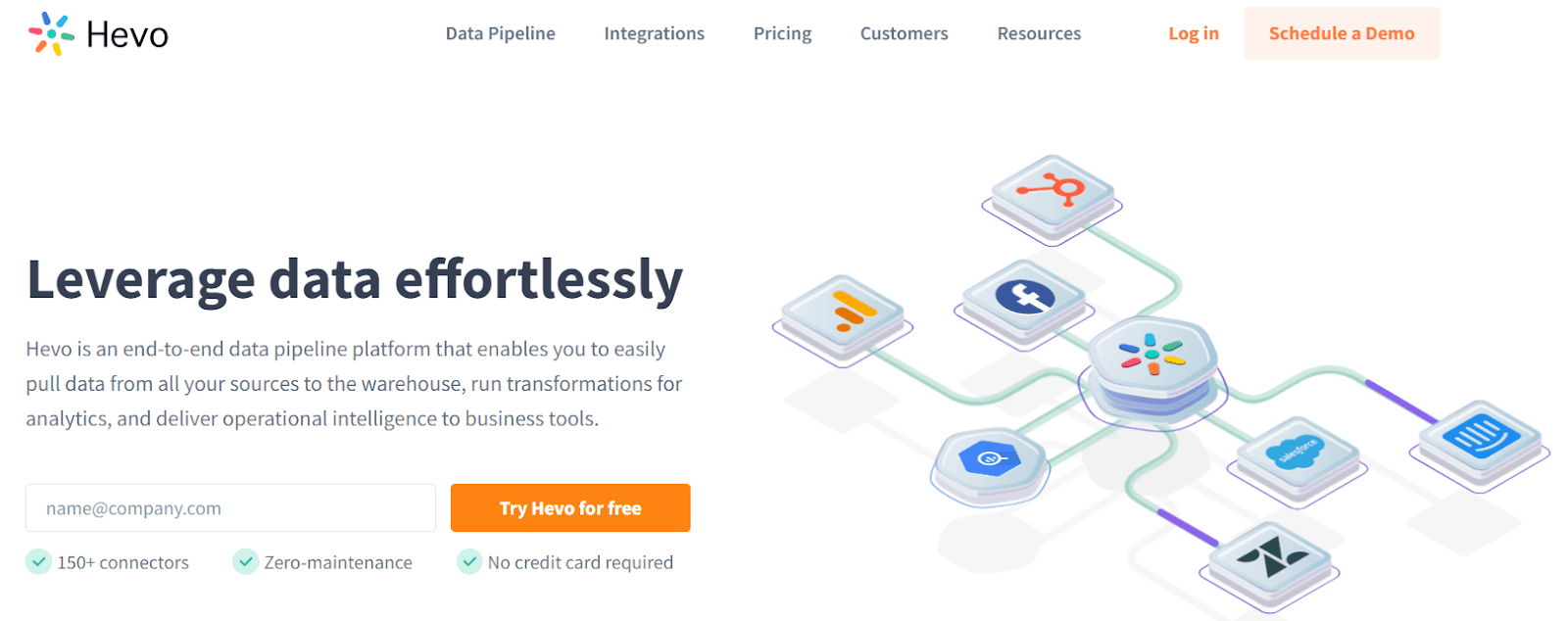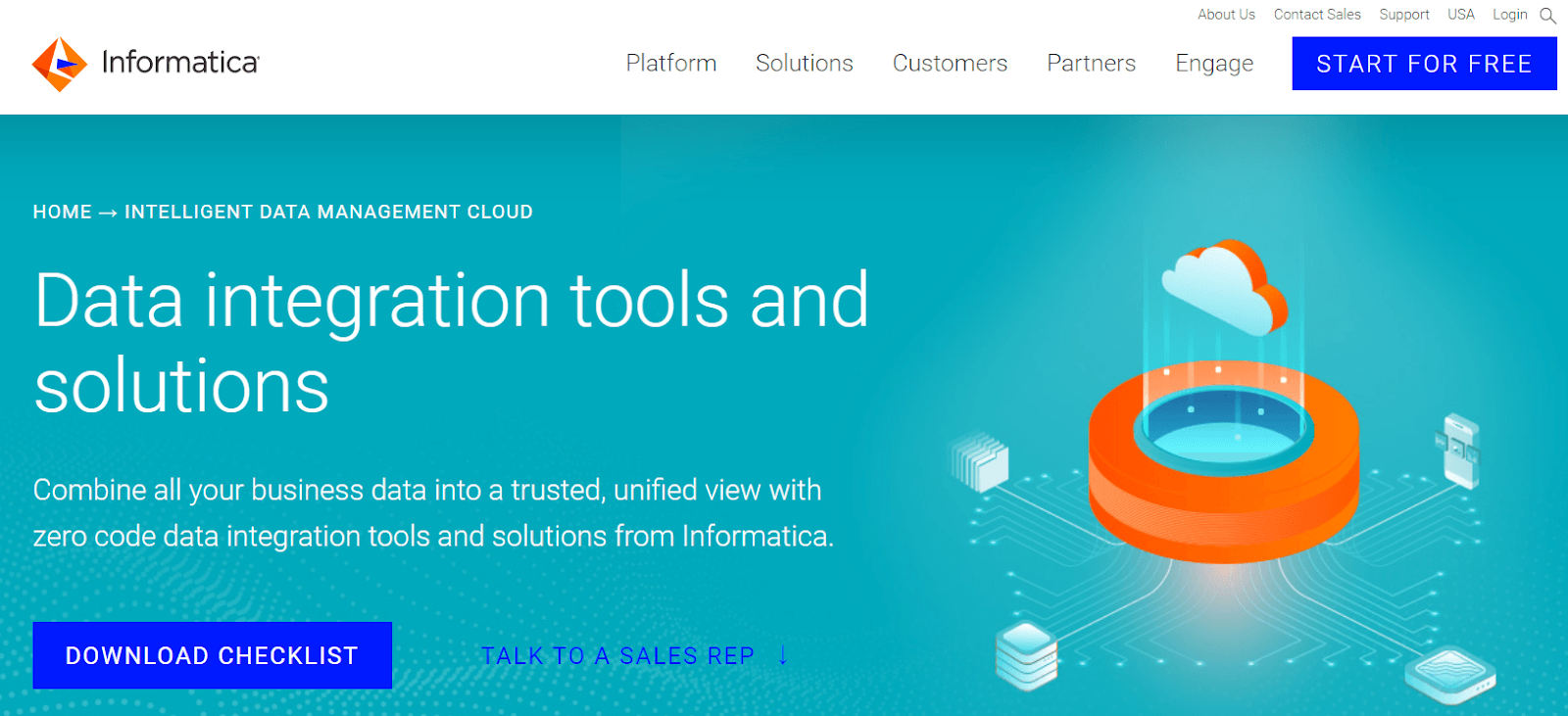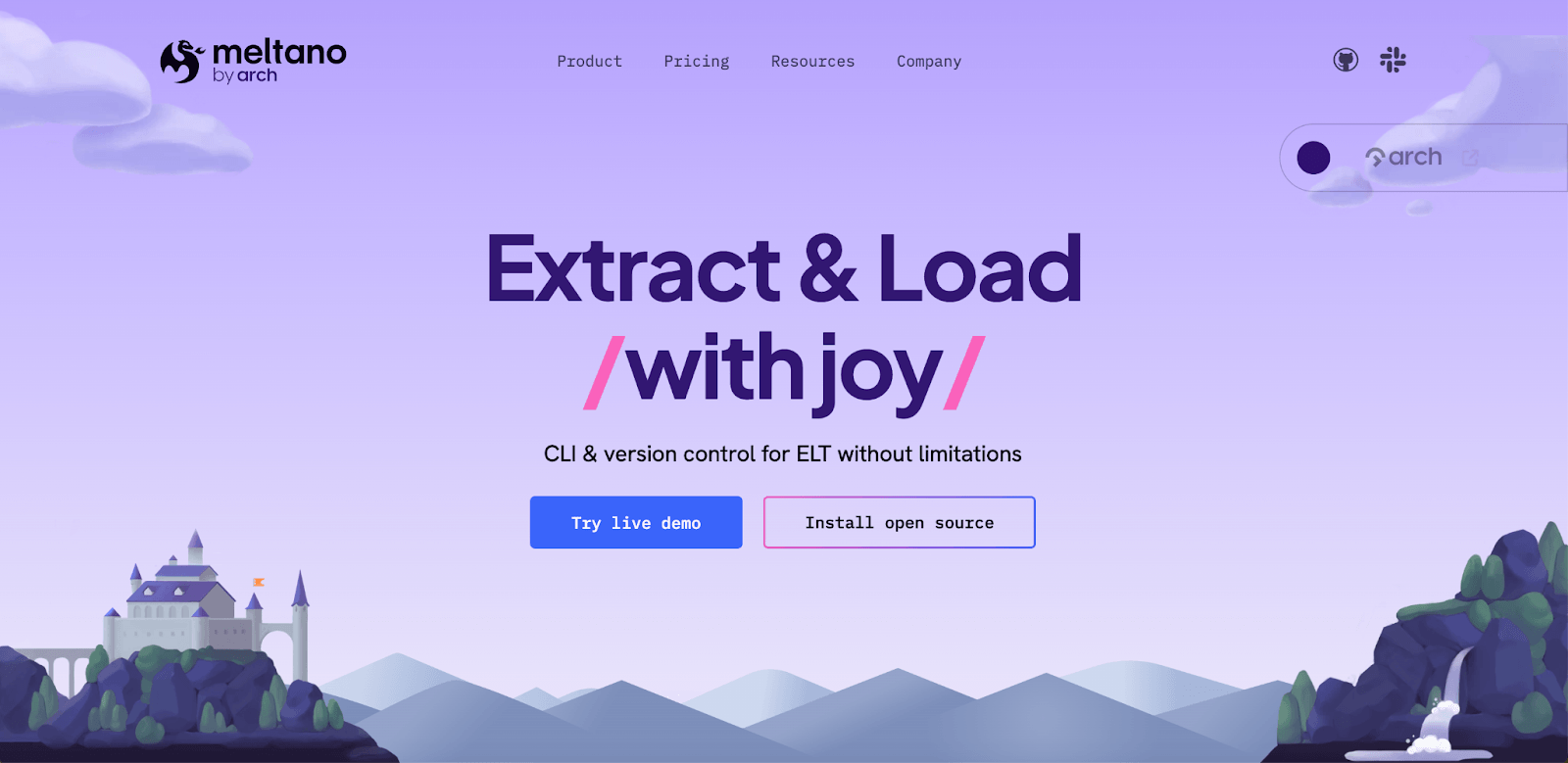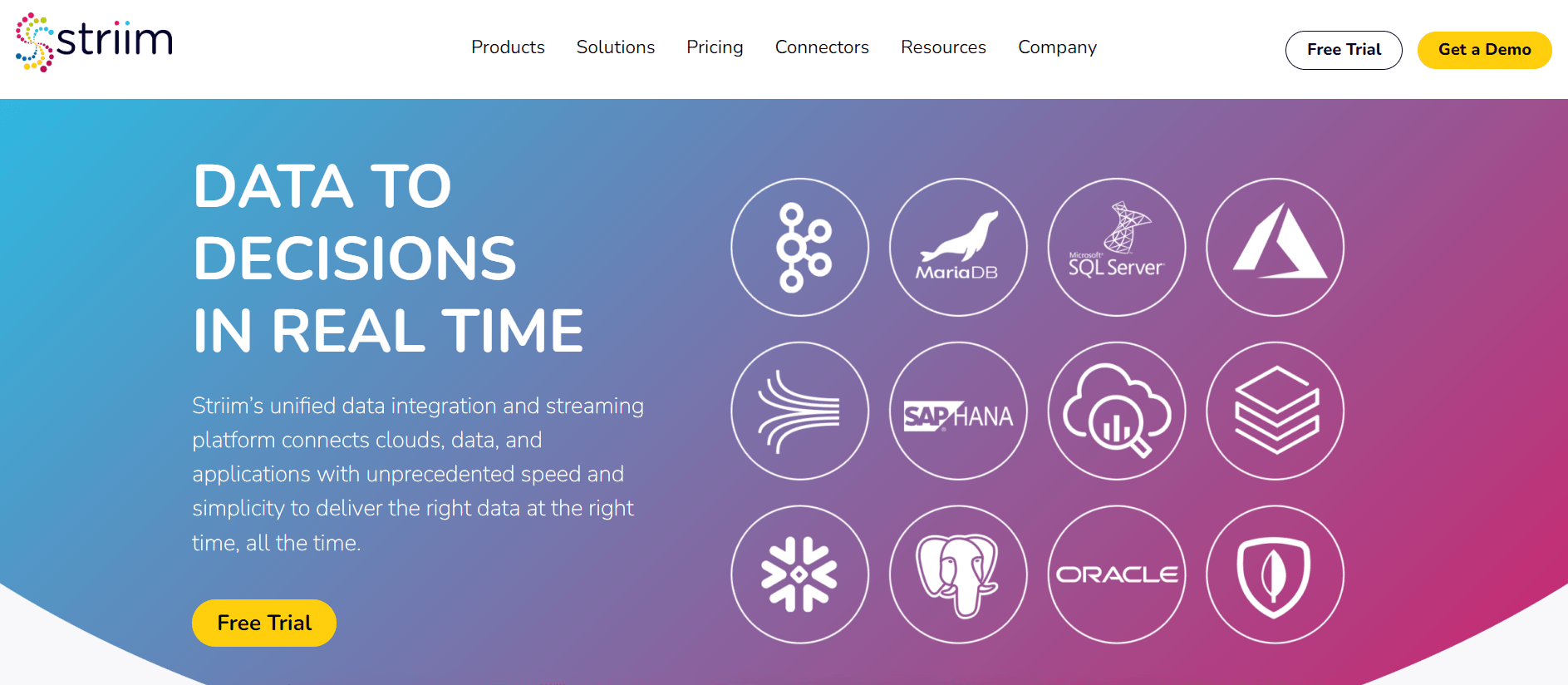
Are you searching for the best Fivetran alternatives to optimize your data integration, ETL, and ELT workflows? Whether you're looking for a cheaper, more flexible, or real-time alternative to Fivetran, choosing the right tool is critical for scalable data pipelines and cost-effective data management.
While Fivetran is a popular cloud-based ELT (Extract, Load, Transform) platform, many businesses seek alternatives due to high costs, batch-only processing, limited real-time capabilities, and lack of control over schema changes.
This guide presents the 11 best Fivetran competitors in 2025, helping you compare real-time vs. batch-based ELT solutions, ETL tools, open-source data integration platforms, and cost-effective alternatives. Whether you need real-time Change Data Capture (CDC), open-source flexibility, or low-cost ELT pipelines, we’ve got you covered!
Why This Guide?
- Covers 11 best Fivetran alternatives – more than basic lists, ensuring you get a 110% complete overview of the best ELT/ETL options.
- Compares pricing, features, pros & cons of real-time ELT, open-source tools, and batch-based competitors.
- Includes cost-effective & high-performance options that outperform Fivetran in scalability, real-time processing, and flexibility.
By the end of this guide, you'll have a clear understanding of which Fivetran alternative best fits your data integration needs in 2025.
Why Consider Fivetrab Alternatives?
While Fivetran is a well-known cloud-based ELT platform, many businesses seek Fivetran alternatives due to its high costs, batch-based data ingestion, and limited flexibility. Here’s why companies switch to better ETL/ELT solutions:
1. High & Unpredictable Costs
- Fivetran pricing is based on Monthly Active Rows (MAR), which can lead to unexpected expenses.
- Non-relational data sources (e.g., NoSQL, APIs) result in excessively normalized tables, increasing MAR counts drastically.
- Certain high-cost Fivetran connectors require full-table replication, driving up costs.
💡 Alternative solutions like Estuary Flow offer predictable, cost-efficient pricing without inflated MAR costs.
2. High Latency – No Real-Time Data
- Fivetran supports batch-only processing, even for Change Data Capture (CDC).
- Delayed updates (hourly or daily) slow down analytics and real-time decision-making.
- Companies needing real-time ELT & streaming pipelines must look for low-latency alternatives.
💡 Consider Estuary Flow or Debezium for real-time data streaming.
3. Limited Control Over Schema Changes
- Fivetran auto-adjusts schema changes, which can break queries and analytics workflows.
- Users cannot rename columns or modify schemas manually, leading to rigid pipelines.
💡 Alternatives like Estuary Flow, Airbyte and Hevo Data offer better DataOps controls.
4. Reliability Issues & Source Database Strain
- Batch-based CDC replication adds stress to databases, sometimes causing performance slowdowns or failures.
- Limited monitoring & error handling make troubleshooting data pipeline failures difficult.
💡 If reliability is a top concern, Estuary Flow offers exactly-once delivery & durable stream storage.
5. Slow & Limited Customer Support
- Many Fivetran users report slow support response times, leading to extended downtimes.
- Lack of transparency around product roadmap and updates leaves customers without clear expectations.
💡 Alternatives like Estuary Flow offer faster, more responsive customer support.
Is It Time to Switch from Fivetran?
If you’re facing cost overruns, high latency, schema rigidity, or performance issues, it’s time to explore modern, real-time ETL & ELT alternatives.
Keep reading to find the best Fivetran competitors that offer more flexibility, real-time data movement, and lower costs.
Fivetran Review: Strengths, Weaknesses, and Pricing Explained
What is Fivetran?
Fivetran was founded in 2012 by data scientists who aimed to create an integrated platform for data capture and analysis. The name, a nod to the Fortran programming language, was chosen to signify a focus on big data. While the initial goal was to offer a complete data stack, Fivetran soon shifted its focus solely to data integration, driven by the needs of its customers.
In 2018, Fivetran raised its Series A funding and later, in 2020, enhanced its offerings by adding support for the Data Build Tool (dbt) and introducing Change Data Capture (CDC) capabilities. The company solidified its commitment to CDC with the acquisition of HVR. Today, Fivetran is a leading ELT provider. It is renowned for its user-friendly platform, which features nearly 300 pre-built connectors and over 300 additional lite (API) connectors, making data integration quick and seamless.
While Fivetran simplifies data ingestion, many businesses encounter scalability, cost, and performance issues, making them seek Fivetran alternatives.
Fivetran's Top Strengths
- Ease of Use: Fivetran is a cloud-based ELT solution featuring an intuitive interface. It allows you to set up data pipelines with minimal coding.
- Pre-built Connectors: Fivetran offers many pre-built connectors for diverse data sources, helping you save time and development effort.
- Scalability: Compared to several other vendors, Fivetran is known for scaling better.
- Integration with dbt: if you like dbt and want to get started with it, Fivetran has done a good job of integrating dbt with the core Fivetran platform.
- Focus on EL: Fivetran excels at data extraction and loading, making it a strong choice if your primary goal is efficiently moving data into your warehouse for analysis.
- Advanced schema evolution: Fivetran and Estuary are the two leading vendors with support for automating how changes in sources are passed through to destinations.
Fivetran's Key Weaknesses
- High latency: Fivetran is batch only, including its CDC connectors. While its HVR acquisition added real-time CDC connectors, they are a different product and pipeline from Fivetran.
- High, unpredictable costs: Fivetran is the most expensive of the modern ELT vendors. It is also the most unpredictable in terms of costs. Some sources require you to replicate all source data. Non-relational sources are converted into highly normalized relational data that gets counted as many more monthly active rows (MAR) than expected. Fivetran customers often don’t understand this until they get the bill.
- Reliability: Fivetran implements batch CDC that extracts full snapshots and processes the source database’s transaction log in batch intervals. Both add stress to a database and have been known even to cause database failures. Alerts, warnings, and failures also lead to additional time spent on handling them.
- Support: Related to reliability issues, when customers complain, support can be slow when things go wrong.
- DataOps: Fivetran offers limited control and visibility over handling your data and schema. It automatically modifies field names and data structures and doesn’t allow you to rename columns, which can complicate migration to other technologies. Additionally, depending on the structure, Fivetran may not always capture all the data and often does not provide clear explanations for these omissions.
- Roadmap: Customers often note that Fivetran is less transparent about its future plans or roadmap compared to other options in this comparison. Additionally, the company doesn't sufficiently address many of the concerns mentioned, such as control over data and schema management.
Fivetran Pricing: How Much Does It Cost?
Fivetran's pricing is determined by monthly active rows (MAR), which can be unpredictable because of the way Fivetran internally represents data and manages non-relational sources. Additionally, reducing latency significantly increases costs. While a small deployment (2M MARs/month) can cost $700-$2667, 10M MARs/month get you into $10K a month. It is not unheard of for Fivetran costs to reach 6 digits annually, especially with certain high-cost connectors that end up having many more MARs.
Next, we’ll compare the 11 Best Fivetran Alternatives, including real-time, open-source, and cost-efficient options.
11 Best Fivetran Alternatives in 2025
Here is a list of the top Fivetran alternatives and competitors:
1. Estuary Flow
Estuary Flow is one of the most robust Fivetran alternatives, excelling in real-time ETL, ELT, CDC, and batch processing. Its easy-to-use user interface lets you build both batch and real-time data pipelines from a wide array of databases, SaaS applications, filestores, and other sources.
Estuary Flow supports both ETL and ELT, meaning you can build streaming transforms using SQL or TypeScript (ETL) or use dbt in your destination. The platform safeguards data in motion and at rest with industry-standard security protocols, including encryption, authentication, and authorization.
Flow is an ideal solution for syncing data across multiple systems in real-time. With support for 100s of connectors, Flow makes it simple to connect to a wide range of data sources and destinations, offering a seamless data integration experience. Additionally, the platform’s flexibility allows for easy scaling as your data needs grow, making it a future-proof choice for any organization.
Pros
For the most part, if you are interested in a public or private cloud option and the connectivity options exist, you should evaluate Estuary. It has many strengths, partly because it is a relatively new vendor.
- Lowest latency: Of all these vendors, Estuary is the only ELT/ETL vendor in this comparison with sub-second latency.
- Real-time and batch: Estuary is the only vendor supporting real-time and batch, allowing you to mix them in a single pipeline. This is useful for extracting in real-time with CDC and loading a data warehouse in batches to save costs.
- ETL and ELT: Flow supports streaming SQL, and TypeScript transforms (ETL) and dbt (ELT).
- Built-in data storage and replay: Estuary automatically stores the data as it streams for future replay and time travel.
- Advanced schema evolution: Estuary and Fivetran are the two leading vendors that support automating how changes in sources are passed through to destinations.
- Multiple destinations: Estuary supports loading multiple destinations with a single pipeline, unlike most ELT vendors that only support 1 destination per pipeline.
- Highest scale: While it might not be immediately apparent without running your own benchmarks, Estuary stands out as the most scalable ETL/ELT vendor. It’s the only platform capable of performing incremental snapshots, showcasing 5-10x the scalability compared to competitors like Airbyte, Fivetran, and Hevo. The only alternatives that come close to this level of scale are Debezium (Kafka) and Striim.
- Most efficient: Estuary also leads in efficiency with the fastest and most effective CDC connectors. It is the only vendor that offers exactly-and-only-once capture, minimizing system load—particularly when supporting multiple destinations, such as a data warehouse, high-performance analytics database, AI engine, or vector database.
- Private cloud: Estuary is currently the only vendor to support private cloud deployments, which involve a data plane deployed in a customer private account managed by a shared SaaS control plane. It’s the privacy of on-prem with the simplicity of SaaS. Your next-best option is self-hosted open source.
- Most reliable: Estuary’s exactly-once transactional delivery and durable stream storage contribute to its reputation as the most reliable data pipeline vendor.
- Lowest cost: Estuary emerges as the clear winner in terms of cost-effectiveness, offering the lowest costs for data processing at any volume.
- Great support: Customers frequently highlight Estuary's exceptional support as a key reason for choosing and sticking with the platform.
Cons
- New vendor: Estuary Flow is a relatively new company compared to some other vendors. While it is open source and the core framework has been maturing for 10 years, the connectors and data integration services are 5 years old.
- 150+ connectors: Estuary Flow has 150+ connectors built by Estuary, which is less than Fivetran. While it also supports 500+ open-source connectors, open-source connectors are not always complete. Make sure you evaluate your connectors before moving forward.
Pricing
Estuary Flow offers these flexible pricing plans:
- Free: Up to 2 connectors and 10 GB/month
- Cloud (30-day free trial): $0.50/GB change data moved +$0.14/hour/connector
- Enterprise pricing available
If you want to get your data where you want it in milliseconds, try Estuary Flow for free. It provides a comprehensive data integration platform that is suitable for a variety of data integration tasks.
2. Airbyte
Airbyte was established in 2020 as an open-source data integration company and expanded its offerings by launching a cloud service in 2022.
Initially built on the Singer protocol as an ELT tool, Airbyte has since evolved by developing its own unique protocols and connectors. Despite these changes, it has maintained compatibility with Singer taps to ensure continued support where needed. However, Airbyte has also retained many of its original batch-based principles, which can lead to certain limitations in its functionality.
Airbyte has emerged as a prominent alternative to Fivetran, particularly for those concerned about costs or seeking a self-hosted open-source solution. When comparing Airbyte vs Fivetran, Airbyte's open-source nature offers users greater flexibility and control, whereas Fivetran focuses on ease of use with pre-built connectors. According to pricing calculators and customer feedback, it ranks as the second most cost-effective option in the market, following Estuary. Additionally, Airbyte's open-source nature gives users greater flexibility and control, making it an attractive choice for organizations looking to customize their data integration processes.
Pros
- Ease of use: like other ELT vendors, Airbyte is easy to use.
- Low cost: Airbyte Cloud is one of the lower cost options, higher than Estuary but lower than most of the others.
- Widely used: Although Airbyte is a relatively new product (4 years old), it is widely used with thousands of deployments. Most customers use the open-source version. The official 1.0 product launch, the big milestone for any open-source project, is planned for September 2024.
Cons
- 60+ managed connectors, 300+ total: Airbyte lists 300+ connectors. But only 50+ of these are connectors actively managed by Airbyte. The rest are open-source connectors listed as Marketplace connectors for Airbyte Cloud. So, while they have built a sizable list for a newer vendor, you need to evaluate the connectors based on your needs.
- High Latency: Airbyte open source is batch only. While the self-hosted open source can load in 5 minutes or more intervals, Airbyte Cloud only supports 1+ hour intervals and one source connector at a time. There is no staging or storage, so the pipeline stops if something goes wrong with either source or target.
- Reliability: You should be aware of specific reliability challenges with Airbyte. For instance, Airbyte only guarantees delivery at least once, which might not meet all use cases. However, it does offer both incremental and deduplication modes, though you'll need to enable these features manually. A more significant reliability concern is the potential failure of under-sized workers, which can disrupt your data processes. Additionally, Airbyte pipelines lack built-in staging or storage to preserve state, meaning that if you need to access the data again, you'll have to re-extract it from the original source.
- Scalability: Airbyte is not known for scalability. It has scalability issues that may not make it suitable for larger workloads. As of the time of this writing, its latest benchmark produced 9MB/sec throughput, which is 0.5TB a day or so, depending on how loads vary throughout the day. Note that this was the new self-hosted Postgres CDC connector, not the Airbyte cloud.
- ELT only: Airbyte cloud supports dbt cloud but is ELT only. If you want to implement transforms outside of the data warehouse, Airbyte does not support that.
- DataOps: Airbyte’s replication is designed with a simple, UI-driven approach for ease of use. However, it doesn’t provide an "as code" option, which can be a drawback if you need to automate pipelines, implement tests, or handle schema changes effectively.
Pricing
Airbyte starts at $10 per GB of data moved from a database, and $15 per million rows of data moved via an API (or custom source). There are volume-based discounts. You also pay for backfills.
3. Debezium
Debezium originated within Red Hat, building on the release of Kafka and Kafka Connect, and was influenced by Martin Kleppmann’s concepts on Change Data Capture (CDC) and the idea of "turning the database inside out."
For those dedicated to open-source solutions and possessing the specialized resources necessary to construct their own scalable pipeline infrastructure, Debezium stands out as an excellent option. As one of the leading Fivetran alternatives open source, Debezium offers flexibility for organizations requiring open-source CDC solutions. Its flexibility and strong community support make it particularly well-suited for organizations with complex data integration needs.
Pros
- Open-source CDC: Debezium is the open-source standard for the CDC. It’s used in many open-source deployments and by several vendors, including Confluent and several ELT vendors.
- Broad CDC support: Debezium has one of the most extensive lists of sources it supports. It can also be loaded into many destinations via Kafka, which it uses as its streaming layer.
- Modern CDC: Debezium supports immediate transaction log reads and incremental snapshots (DDD-3), which is better than many other CDC implementations.
- Proven: Debezium is widely used today.
Cons
- Build, not buy: Debezium will require specialized data engineering and admin resources because it’s open source and not a full data integration offering.
- Limited connectivity: You can leverage all the Kafka Connect-based connectors to over 100 different sources and destinations. But they have a long list of limits (see confluent docs on limits). You will also need to build non-CDC source and non-Kafka connectivity.
- Real-time only: Debezium does not support batch processing for sources or destinations, so if you need it, you’ll need to build it or rely on another tool.
- Limited schema evolution - While the Kafka Schema Registry does support message-level schema evolution, the limitations on destinations and the translation from sources to messages make this much harder to manage.
Pricing
Debezium is free and open-source. Your costs will be based on the specialized resources you’ll need to deploy and manage.
Your other option is to use Confluent Cloud, which will help simplify your administrative costs. However, you will still need to configure and manage Debezium and your Kafka cluster, and the costs will exceed some, including Estuary and Airbyte.
If Kafka is already the core of your data infrastructure, it’s wise to consider Debezium as a complement. Opting for Confluent Cloud can streamline your deployment process, though it comes with additional expenses.
4. Hevo Data
Hevo Data is a no-code SaaS data pipeline platform that started as a cloud service in 2017. Hevo is primarily ELT but has been adding some row-based ETL support.
Pros
- Ease of use: Like several other ELT vendors, Hevo is intuitive and easy to use.
- ELT and ETL: Hevo has started to add more transformation capabilities, including Python scripts and a new drag-and-drop editor (in Beta.) This is more for row-level transformations. Hevo’s main transformation support, especially for doing more complex transforms involving merging data, is dbt (ELT)
- Reverse ETL: Hevo supports inserting source data back into the source once it’s been cleansed. If you’re looking for this feature, this might be good for you.
Cons
- Connectivity: Hevo offers a little over 150 connectors, which is relatively fewer than some other platforms. While this is still a significant number, it’s essential to carefully consider the sources and destinations you’ll need for both your current and future projects to ensure that Hevo can meet your requirements.
- Latency: Hevo is still batch only. Hevo connectors to sources are batch with a 5-minute minimum delay. Also, there is currently no standard scheduler. So, end-to-end latency becomes longer as the sources and targets operate with different intervals and schedules.
- Costs: Hevo is a viable option for low data volumes, comparable to Estuary when dealing with just a few gigabytes per month. However, as your data volumes grow into the tens of gigabytes per month, Hevo becomes more costly than both Estuary and Airbyte. The costs can escalate further if you aim for lower latency, as several of Hevo's connectors don’t fully support incremental extraction. Reducing your extract interval can lead to capturing the same events multiple times, significantly driving up expenses.
- Reliability: CDC is batch mode only, which can load CDC sources and even cause failures. Customers have also complained about Hevo bugs that make it into production and cause downtime.
- Scalability: Hevo has certain scalability limitations, some of which can be adjusted. For instance, the 50MB limit on Excel files and the 5GB limit on CSV/TSV files can be increased by reaching out to support. However, many restrictions are fixed, such as column limits and a 25 million row cap per table during initial ingestion. Additionally, custom scheduling is confined to 24 specific times, and API calls are capped at 100 per minute, which can pose challenges for more demanding data integration tasks.
Users have reported high CPU usage, which can cause system slowdowns. - DataOps: Hevo lacks CLI or "as code" automation capabilities, limiting your ability to automate processes fully. While you can manually map to destination tables, this doesn’t allow for complete automation of schema evolution or control over rules. There is no built-in schema testing or evolution management. Although new tables can be processed, significant column changes may prevent data from being loaded into destinations. Instead, the data is moved to a failed events table, which must be resolved within 30 days, or the data will be permanently lost.
Pricing
- Free: Limited to 1 million free events per month with free initial load, 50+ connectors, and unlimited models
- Starter ($239/mo): Offers 150+ connectors, on-demand events, and 12 hours of support SLA
- Business (Custom Pricing): HIPAA compliance with a dedicated data architect and dedicated account manager
5. Informatica
Informatica offered one of the first ETL products, Powercenter, in 1993 and one of the first cloud integration products, Informatica Cloud, in 2006. Informatica Cloud was initially built based on an older version of Informatica PowerCenter and eventually upgraded to a newer version of the on-premises data integration based on Hadoop and then Spark.
Informatica is perhaps the best example of a mature data integration platform. While it was one of the first to make the transition to the cloud and has one of the strongest and broadest data integration feature sets, it is more complicated to use, more expensive, and not as DataOps-native. However, it offers robust enterprise features and is one of the strongest private cloud architectures available.
Pros
- A comprehensive data management platform: Informatica Intelligent Data Management Cloud goes beyond traditional ETL-based integration, offering a wide array of features, including data replication, data quality management, and master data management.
- Rich data integration functionality: Informatica has developed a rich library of capabilities for data integration over the years.
- Great connectors: Over 300 connectors, including proven connectors to high-performance on-premises and cloud data warehouses.
- Performance and scalability: Informatica is built to support large deployments and deliver low-latency data pipelines at scale. For years, it has supported serverless compute, pipeline partitioning, push-down optimization, and other features.
- Private cloud: Informatica is one of the few vendors that supports private data plane deployments managed by a shared SaaS control plane.
Cons
- Harder to learn: While Informatica Cloud is easier to learn than Powercenter, it still has a significant learning curve compared to most SaaS ELT services. This makes it more suitable for larger, specialized data integration teams.
- Doesn’t support DataOps as well: Informatica Cloud was built pre-CI/CD and DataOps. Versioning and other tasks are more complex than some of the more modern ELT tools.
- Higher vendor costs: Informatica is more expensive than ELT vendors, perhaps with the exception of Fivetran.
Pricing
No one is going to accuse Informatica of being cheap. Informatica’s consumption-based pricing is complicated and requires a quote. You can read the Informatica Cloud and Product Description Schedule here. Cloud pricing is mostly based on hourly pricing per compute unit, with some other pricing, like row-based pricing for CDC-based replication.
6. Matillion
Matillion ETL is a mature on-premises ETL platform often listed among the top Fivetran alternatives, supporting cloud data platforms like Snowflake, Amazon Redshift, and Google BigQuery. It combines many features to extract, transform, and load (ETL) data. The Matillion Data Productivity Cloud offering consists of a Hub for administration and billing, a choice of working with Matillion ETL deployed as a “private cloud” or Matillion Data Loader, a free cloud batch and CDC replication tool built on ETL but lacking ETL capabilities.
As with most mature ETL tools, Matillion has a strong feature set but is harder to use, has not fully transitioned to the cloud or DataOps, and is more expensive.
Pros:
- Advanced ETL: Matillion ETL supports various transform options, from drag-and-drop to code editors for complex transformations.
- Workflow orchestration: Matillion also offers advanced graphical workflow design and orchestration.
- Pushdown Optimization: Matillion ETL pushes down transformations to the target data warehouse whenever possible.
- Reverse ETL: Matillion allows you to extract data from a source, cleanse it, and insert it back.
Cons:
- Limited SaaS: Matillion ETL, its flagship product, is on-premises only. It offers a free cloud service, Data Loader, for replication and integration with the Matillion Cloud Hub for billing. While you can migrate your work to ETL if you choose, it is a migration from the cloud to your own managed environment.
- Limited free tier: Unlike some competitors, Matillion ETL offers a limited free cloud tier (Data Loader) with restricted (EL) functionality, including no transforms. This can make it challenging to fully evaluate the tool before committing to a paid plan.
- Limited connectors: Matillion actually has fewer connectors than most (120+ in total.) You can invoke external APIs. It’s important for any vendor to evaluate each connector to make sure it suits your needs.
- Limited schema evolution: Matillion does support adding columns to existing tables, deleting a column, and handling data type changes. However, adding a table requires creating a new pipeline, and change management is not automated.
- Lack of dbt integration for SaaS: While Matillion ETL does support dbt, there is no integration between Data Loader and dbt.
Pricing
Matillion doesn’t have a pay-as-you-go model. It starts at $1000/month for 500 credits, each credit being a virtual core hour similar to an AWS, Azure, or Google virtual core. Pricing increases by 25% per credit for advanced and 35% for enterprises with higher base commitments.
This platform typically costs thousands of dollars per month at minimum. Data Productivity Cloud consumes credits for every running task, with a credit used every 15 minutes the task is active. The smallest ETL unit operates on two cores, meaning you consume two cores per hour, which can quickly add up to nearly three times the 500-credit baseline each month.
7. Meltano
Meltano was established in 2018 as an open-source project within GitLab to assist their data and analytics team. It’s a Python framework based on the Singer protocol. Originally developed by the founders of Stitch, the Singer framework saw reduced contributions after Stitch was acquired by Talend, which was later acquired by Qlik. Despite these changes, Meltano has continued to grow, driven by a strong community and its commitment to open-source principles.
Compared to other Fivetran alternatives, Meltano is focused on configuration using YAML and the CLI. Most users prefer the no-code approach, even with Estuary, which fully supports configuration and DataOps.
Overall, Airbyte and Meltano are strong ELT choices for those prioritizing open-source tools. If ease of use is your main concern, Airbyte could be the more suitable option. If you prefer more configuration and development, Meltano is better. Estuary Flow is your other option.
Pros:
- Open source ELT: Meltano is the main successor to Stitch if you’re looking for a Singer-based framework.
- Configure-driven: If you are looking for a configure-driven approach to ELT, Meltano may be a great option.
- Connectivity: Meltano and Airbyte collectively have the most containers, which makes sense given their open-source history with Singer. Meltano supports Singer and has an SDK wrapper for Airbyte, giving it 600+ open-source connectors. Open-source connectors have limits, so it’s important to test them carefully based on your needs.
Cons:
- Configure not low-code: Meltano is not a good choice if you’re looking for a more graphical, low-code approach to integration.
- Latency: Meltano does not support streaming. It’s batch only. While you can reduce polling intervals down to seconds, there is no staging area. The extract and load intervals need to be the same. For this reason, Meltano is best suited for historical analytics.
- Reliability: Some will say Meltano has fewer issues than Airybte. But it is open source, so if you have issues, you can only rely on the open source community for support.
- Scalability: Meltano lacks extensive documentation for scaling, and it’s not typically recognized for its scalability, particularly when low latency is required. Benchmarks indicate that using larger batch sizes can improve throughput, but it still doesn’t reach the performance levels of Estuary or Fivetran. Even in batch mode, processing 100K rows usually takes several minutes.
- ELT only: Meltano offers strong support for open-source dbt, allowing you to import existing dbt projects seamlessly. Its integration with dbt is well-regarded, and it also includes the capability to extract data directly from dbt Cloud, making it a versatile tool for those working within the dbt ecosystem.Meltano does not support ETL.
- Deployment options: Meltano is available as a self-hosted open-source solution, with no Meltano Cloud offering. However, Arch, the company that actively contributes to Meltano, provides additional services and consulting for analytics, offering broader support for organizations using the platform.
- DataOps: Meltano is all about configuration. Data engineers typically use the CLI or the Meltano API for automation. While automating pipelines is relatively straightforward, the platform offers limited support for schema evolution and automating responses to schema changes, which can pose challenges in managing dynamic data environments.
Pricing
It’s open source. There is no pricing. But it’s not a free lunch. You’ll need to spend more on data engineering resources to stand up, build, and maintain Meltano. If you need scalability, there isn’t a lot of documentation on how to scale, so make sure you evaluate carefully, and have the Meltano expertise in-house.
8. Stitch
As one of the established Fivetran competitors, Stitch is a SaaS-based batch ELT tool developed from the Singer open-source project. It was initially created within RJMetrics, and when Magento acquired RJMetrics in 2016, Stitch spun off as an independent company. In 2017, Stitch made contributions to the Singer open-source project, and in 2018, it was acquired by Talend. Stitch is utilized by over 3,000 companies, with even more organizations leveraging the Singer framework.
Stitch calls itself ETL; it’s not. Stitch is batch ELT that does basic data conversions so that it can move raw data from each source to the target, just like most other ELT technologies. Like most other vendors, it also only supports soft deletes.
If you’re an existing Singer or Stitch user, you should be considering what to use for new projects because more innovation is going into other platforms. The Talend acquisition left Singer without a significant company driving its innovation. By the time Talend was acquired by Qlik, investment in Singer and Stitch seemed to have slowed down. Meltano had become more of an investor in the Singer project.
Meltano, AIrbyte, and Estuary may give you a smoother transition since they both support Singer taps (connectors). However, you should be able to find other vendors who can support your needs.
Pros
- Open-source: Singer is a robust open-source framework, and multiple options, such as Stitch, Meltano, Airbyte, and Estuary, can support Singer taps.
- Log retention: Stitch provides up to 60 days of log retention for recovery, a feature that outperforms many other vendors, with Estuary being one of the few exceptions.
- Support: Qlik offers support for Stitch.
- Integration with other Qlik products: If you're already a Qlik customer, sticking with Stitch makes a lot of sense because it seamlessly integrates with other Qlik offerings.
Cons
- Lack of investment: A quick glance at the Stitch changelog reveals that there hasn't been significant investment in either the Singer framework or Stitch itself.
- Pricing: You will most likely spend $1250+ a month on any reasonable deployment. If you need a VPN/private link and a high level of support, you will need Premium at a minimum of $2500 a month. At that price you can consider several other ELT vendors along with Estuary.
- Limited connectors: Stitch currently supports just over 140 taps (connectors), which, while substantial, falls short compared to several other platforms. Although more than 200 Singer connectors are available, the quality can be inconsistent. Additionally, the pace of new connector additions has slowed, so if you require a broader range of connectors, this could be a limitation.
Pricing
Stitch starts at $100 per month/$1000 per year for the most basic plan, which offers 3 million rows per month, $1250 a month for Advanced, which offers 100 million rows, and $2500 for Premium, which offers 1 billion rows per month.
Also Read: Stitch Data Alternatives
9. Striim
Striim, pronounced "Stream," started as a replication and stream processing vendor but has since expanded into the broader data integration space.
In 2012, several key figures from GoldenGate came together to establish Striim. Initial efforts focused on utilizing CDC replication for replication, stream processing, and analytics. Over time, they expanded the platform by adding connectors to support a variety of data integration use cases.
Whether you need real-time replication or more complex stream processing, Striim is a great and proven vendor option. It has some of the best CDC, including its Oracle database support. If you have the skill sets to do stream processing, it can also be a good option for supporting stream processing and data integration use cases.
Pros
- Real-time support: Striim has great support for real-time replication, streaming transforms, and loading into multiple destinations.
- Performance and scalability: Striim along with Kafka and Estuary are the three technologies that can scale to gigabytes per second for pipelines with sub-second end-to-end latency.
However, its origins in stream processing are its weakness for data integration use cases.
- Complex transforms: Tungsten Query Language (TQL) is a SQL-like language tailored for stream processing. While it offers considerable power, it’s more complex than standard SQL, which can present a learning curve.
- Complex orchestration: Striim Flows provide a robust graphical tool for stream processing, but they require time to master. You’ll need to create flows (or utilize TQL) for each data capture, making Striim more complex than typical ELT vendors when building CDC flows from source to destination.
- No data store and replay: While Striim can persist streams to Kafka for recovery, it does not support permanent storage. There is no mechanism for backfilling new data or destinations later without taking a new snapshot.
- Pricing: Striim offers a free tier with up to 10 million events per month. However, paid deployments start in the $1000s monthly, similar to ETL vendors.
Pricing
Striim starts with Striim Developer, a free option of 10 million events per month with community support. Then it’s starting at $1,000 monthly for deploying to BigQuery, Databricks, or Snowflake in real-time, or $2,000 monthly for broader connector support. You also pay $0.75 (or $0.60) per virtual CPU-hour and $10.10 per GB in or out. Mission Critical requires a conversation, which sounds like more of what an enterprise should be with a 99.9% SLA, horizontal scaling, partitioning, and enterprise support.
10. Talend
Talend, now part of Qlik, has two main products: Talend Data Fabric and Stitch (covered under Stitch). Talend Data Fabric is a data integration platform that, like Informatica, is broader than ETL. It also offers data quality and data governance features, ensuring that your data is not only integrated but also reliable and well-managed.
Talend also had an open-source solution, Talend Open Studio, to help you kickstart your first data integration and ETL projects. You could use Talend Open Studio for data processes that require lightweight workflows. However, Qlik has discontinued it.
Pros
- ETL platform: Data Fabric provides robust transformation, data mapping, and data quality features that are essential for constructing efficient data pipelines.
- Real-time and batch: The platform supports both real-time and batch processing, including streaming CDC. While the technology is mature, it still offers true real-time capabilities.
- Strong monitoring and analytics: Similar to Informatica, Talend offers robust visibility into operations and provides strong monitoring and analytics capabilities.
Cons
- Learning curve: Talend features an older UI that requires some time to master, much like other ETL tools. Developing transformations can also be time-consuming.
- Limited connectors: Talend claims 1000+ connectors. But it lists 50 or so databases, file systems, applications, messaging, and other systems it supports. The rest are Talend Cloud Connectors, which you create as reusable objects.
- High costs: There is no pricing listed, but it costs more than most pay-as-you-go tools, including Stitch.
Pricing
Outside of the discontinued Open Studio and the open-source Singer framework, pricing for Talend is available upon request. This suggests that Talend's costs are likely to be higher than those of many pay-as-you-go ELT vendors, with the exception of Fivetran.
11. Qlik
Qlik provides three data integration products - Stitch (covered under Stitch) Talend Data Fabric (covered under Talend) and Qlik Replicate, which was originally Attunity. Qlik Replicate has both on-premises and cloud replication deployment options for streaming real-time data.
Qlik Replicate is based on more traditional replication. It performs full snapshots before starting to replicate the stream. But it is a proven replication offering.
Pros
- Easy to use CDC replication: you’re able to configure new pipelines in a UI.
- It supports both cloud and on-premises: unlike most modern ELT tools, you can not only capture from on-premises and cloud sources. You can also stream to both cloud and on-premises data warehouses, including Teradata, Vertica, Hana, or Exadata.
- Strong monitoring: Provides centralized monitoring and visibility via Qlik Enterprise Manager
Cons
- Older product: While Qlik Replicate is proven, it is older. Attunity was founded in 1988 and acquired by Qlik in 2019, 4 years before Qlik acquired Talend. The future direction of these different integration products is unclear.
- Traditional CDC: In the event of connection losses, a full snapshot is required before resuming the transaction log reading process.
- Replication only: Replicate is limited to CDC sources and mostly data warehouse destinations. If you need a broader data integration platform. It’s the wrong choice.
Pricing
Pricing plans for both on-premise and cloud solutions are available upon request from sales, which means it will be more costly than several of the pay-as-you-go ELT plans, or even Confluent Cloud and its support for Debezium.
Conclusion: How to choose the best Fivetran alternate tools
If you're looking for a cloud-based solution and the necessary connectivity is available, Estuary is worth considering as a Fivetran alternative or replacement. In fact, many Estuary users initially started with Fivetran before making the switch.
- Lowest latency: Estuary stands out as the only ELT/ETL vendor in this comparison with sub-second latency, offering unmatched speed.
- Highest scale: Estuary’s scalability is unparalleled, especially with CDC. It is the only vendor capable of performing incremental snapshots, and it has demonstrated 5-10 times the scale of competitors like Airbyte, Fivetran, and Hevo. Estuary is the only viable option if your data needs involve moving a terabyte a day from a source.
- Most efficient: Estuary leads the pack with the fastest and most efficient CDC connectors. It’s also the sole vendor offering exactly-and-only-once capture, minimizing system load, particularly when supporting multiple destinations such as data warehouses, high-performance analytics databases, and AI engines or vector databases.
- Most reliable: Estuary’s exactly-once transactional delivery and durable stream storage contribute to its reputation as the most reliable data pipeline vendor.
- Private Cloud: Estuary is among the few modern ELT/ETL vendors that offer true private cloud deployment. Alternatively, you might consider deploying your open-source solution or evaluating options like Informatica, Matillion, or Talend.
- Lowest cost: Estuary is the clear leader in cost-effectiveness, offering the lowest prices for data processing at any scale.
- Great support: Customers transitioning from Fivetran to Estuary frequently highlight the excellent support as a key reason for their switch to Estuary.
The most effective way to evaluate your Fivetran alternatives is to assess both your current and future needs in terms of connectivity, key data integration features, as well as performance, scalability, reliability, and security requirements. Use this information to select the solution that best aligns with your short-term and long-term goals.
FAQs
Is there a free alternative to Fivetran?
Yes, tools like Estuary and Airbyte offer free tiers. Estuary provides up to 2 connectors and 10GB/month at no cost, making it ideal for smaller projects.
What is the best Fivetran alternative for real-time data integration?
Estuary Flow stands out for its sub-second latency and support for both batch and real-time pipelines.
Why is Fivetran so expensive?
Fivetran's pricing is based on Monthly Active Rows (MAR), and normalized non-relational data can lead to inflated row counts, making costs unpredictable.
Getting Started with Estuary
- Getting started with Estuary is simple. Sign up for a free account.
- Make sure you read through the documentation, especially the get started section:
- I highly recommend you also join the Slack community. It’s the easiest way to get support while you’re getting started.
- If you want an introduction and walk-through of Estuary you can watch the Estuary 101 Webinar.
- Questions? Feel free to contact us anytime!
Related Top Tools Blogs:

About the authors
With over 15 years in data engineering, a seasoned expert in driving growth for early-stage data companies, focusing on strategies that attract customers and users. Extensive writing provides insights to help companies scale efficiently and effectively in an evolving data landscape.
Rob has worked extensively in marketing and product marketing on database, data integration, API management, and application integration technologies at WS02, Firebolt, Imply, GridGain, Axway, Informatica, and TIBCO.







